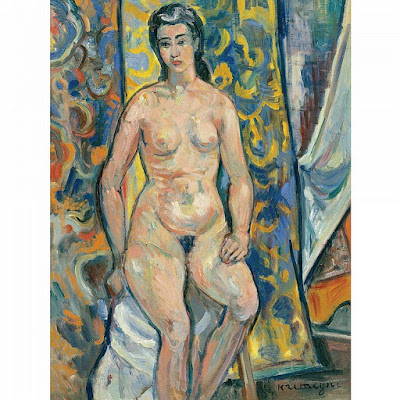 |
| Pinchus Krémègne |
 |
| Portrait of Pinchus Krémègne by Amedeo Modgliani, 1916. Kunstmeseum, Berne. |
by Samuel D. Gruber
Today is the anniversary of the death of Lithuania-born Jewish artist Pinchus Krémègne, an important member of the so-called School of Paris, and a close friend and associate of Chaim Soutine. Though less well-known today than his friends and rivals Soutine, Chagall, Kikoine, Modigliani (who painted his portrait) and others, Krémègne was long-lived and produced an impressive body of work. Most of his paintings are landscapes, townscapes, portraits and nudes - he shied away from social and political painting, and from controversial and conceptual work, and we do not know of any overtly "Jewish" themes in his work - though there may be some lesser known works or in work he did in Israel in the early 1950s. Much of the latter part of his life was spent in Ceret, France, where he created many of his powerfully expressive - and messy - landscapes. Like his colleague Soutine, he loved the materiality of paint.
 |
| Pinchus Krémègne. Provence Landscape, circa 1916 |
 |
| Pincus Kremegne, Les Capucins a Céret. |
 |
| Pincus Kremegne, Landscape. |
"Pinchus Krémègne was the youngest child in a family of nine. His family was religious and humble, and originally came from the Vilnius region. His father produced objects inspired by Slav folklore. When he was nineteen, Pinchus enrolled in the School of Fine Arts in Vilnius, where he studied sculpture and met Soutine and Kikoïne.
Aware that he did not have a future in Russia, where there was much anti-Semitic persecution at the time, he left for Paris in 1912, arriving after a difficult clandestine departure at La Ruche, “this great Russian hive of activity in Passage Dantzig.” Soutine followed his advice and met him there in 1913. In 1914, Krémègne sculpted and exhibited three artworks at the Salon des Indépendants. In 1915, he gave up sculpture and turned to painting.
In Paris, he discovered the museums and galleries that exhibited works by Vincent Van Gogh, Paul Cézanne and the Impressionists.
 |
| Pincus Kremegne, Portrait of a Woman ,c1925 |
 |
| Pincus Kremegne. Standing Nude, 1934 |
From 1916, he spent time in Montparnasse, where he met Kikoïne, André Derain, Maurice de Vlaminck, and Max Jacob. The art dealers Chéron, Zborowski and Paul Guillaume were his first collectors. In 1918, he discovered Céret, which inspired him, and he often stayed there. From 1920, Krémègne started to travel a lot; he went to Corsica (1923), Cagnes-sur-Mer (1928-1929), and Scandinavia, from where he brought many portraits. In 1923, he married Birgit Strömback with whom he later had a son.
In 1940, he took refuge in Turenne in the Corrèze in the Massif Central. He stayed at the house of a villager and helped to work in the fields. A gallery in Toulouse provided him with colors, which enabled him to continue to paint.
Following the Liberation, he returned to Paris and settled in a studio in rue François-Guibert. From 1949 to 1956, he traveled to Israel. However, it was in Cérét that he found the most inspiration. During the 1960s, Krémègne bought a plot in Cérét where he built his “studio-house” and he lived there until he died in 1981."
 |
| Pincus Kremegne. Portrait of unknown seated woman. |
 |
| Pincus Kremegne. Still Life with Bread. |




No comments:
Post a Comment